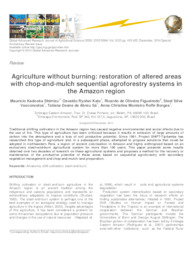Agriculture without burning: restoration of altered areas with chop-and-mulch sequential agroforestry systems in the Amazon region.
Agriculture without burning: restoration of altered areas with chop-and-mulch sequential agroforestry systems in the Amazon region.
Author(s): SHIMIZU, M. K.; KATO, O. R.; FIGUEIREDO, R. de O.; VASCONCELOS, S. S.; SÁ, T. D. de A.; BORGES, A. C. M. R.
Summary: Traditional shifting cultivation in the Amazon region has caused negative environmental and social effects due to the use of fire. This type of agriculture has been criticized because it results in emission of large amounts of carbon into the atmosphere and a loss of soil productive potential. Since 1991, Project SHIFT-Tipitamba has researched this type of agriculture and, in a subsequent phase, attempted to propose solutions that could be adopted in northeastern Pará, a region of ancient colonization in Amazon and highly anthropized based on an exclusively slash-and-burn agricultural system for more than 100 years. This paper presents some results obtained over two decades of research on these agricultural systems and proposes a method for the recovery or maintenance of the productive potential of these areas based on sequential agroforestry with secondary vegetation management and chop-and-mulch land preparation.
Publication year: 2014
Types of publication: Journal article
Unit: Embrapa Eastern Amazon
Observation
Some of Embrapa's publications are published as ePub files. To read them, use or download one of the following free software options to your computer or mobile device. Android: Google Play Books; IOS: iBooks; Windows and Linux: Calibre.
Access other publications
Access the Agricultural Research Database (BDPA) to consult Embrapa's full library collection and records.
Visit Embrapa Bookstore to purchase books and other publications sold by Embrapa.

